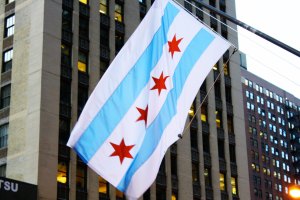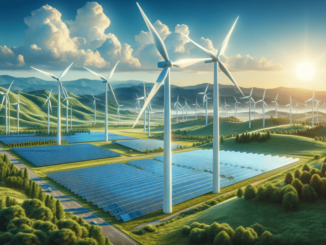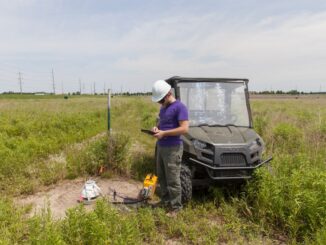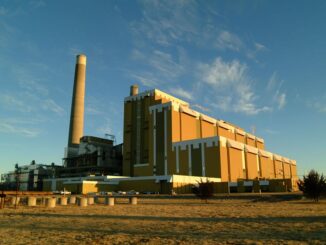
Illinois’ largest solar farm is being built thanks to buy-in from the city of Chicago, helping the city’s government meet its climate goals of 100% clean energy by 2025.
The Double Black Diamond Solar Farm, located in downstate Illinois counties with long histories of coal mining, will have a 600-megawatt capacity, with about half of that devoted to Chicago.
The project will also provide energy to Loyola University and State Farm insurance company. The developer, Boston-based Swift Current Energy, said the total capacity will be enough to power about 100,000 homes and is equal to more than a quarter of Illinois’ current solar capacity, pegged at 2,036 MW last year.
Until 2022, Chicago had no specific commitments for clean energy procurement; a decade-old ordinance just mandated that the city’s power could not come from coal. Constellation, a former Exelon subsidiary that sells Chicago its electricity, has procured power primarily from nuclear and natural gas.
“There could have been renewables in the mix, but they were not being tracked,” said Chicago deputy chief sustainability officer Jared Policicchio.
Get connected
Every morning, thousands of energy professionals turn to our newsletters for the day’s most important news. Sign up for free to get the latest delivered straight to your inbox.
“We’re going to just jump straight to 100%” clean energy, he said. “We’ll go from zero to 100 on New Year’s Eve” of 2024.
The solar farm will offset about 70% of electricity consumption from Chicago’s municipal operations. The city will initially meet the remainder of its 100% goal through purchasing renewable energy credits. Ultimately the credits will be replaced by distributed solar on city property, Policicchio said. The city is using federal American Rescue Plan funding and bonds to begin installing distributed solar, starting with five libraries in disinvested neighborhoods.
On June 2, the U.S. Conference of Mayors awarded Chicago an Honorable Mention in its Climate Protection Award, citing former Mayor Lori Lightfoot’s 100% clean energy commitment. Denver Mayor Michael B. Hancock won the award for large cities, and San Diego, Los Angeles, Tallahassee and Akron mayors also received honorable mention.
Swift Current president and co-founder Matt Birchby said the project is creating 450 jobs lasting about 14 months. Construction is underway, involving labor unions including IBEW, Carpenters, Ironworkers and Teamsters.
The engineering, procurement and construction contractor McCarthy is working with the unions to train workers. Most of the panels and the tracking system will be made in the U.S., and the site will be planted with pollinator-friendly habitat.
“In addition to the team’s efforts on apprenticeship, career development opportunities, and DEI, there is also a heightened focus on biodiversity,” said Grant St. George, a vice president at McCarthy. He noted that McCarthy’s certified soil scientist is consulting on the project.
“They performed early topsoil surveys and seeded the site early to establish proper vegetation, and the site became visibly greener earlier than surrounding acreage.”
The Solar Energy Industries Association predicts Illinois will install more than 5 gigawatts of solar in the next five years, so people trained to work on Double Black Diamond can take those skills to other in-state projects in the future.
“With the [Inflation Reduction Act] and economic impact on the respective communities, these solar projects are establishing career opportunities for professionals of all ages and developing skills that provide the ability to learn, adapt and grow fast,” St. George said.
Loyola University’s 12-year contract with the solar farm will help the Jesuit university meet its goal of being carbon neutral by 2025, including by purchasing 81,660 megawatt-hours of electricity in the solar farm’s first year.
The solar farm will augment the university’s sustainability curriculum, which includes a School of Environmental Sustainability launched in 2020, extensive rainwater management infrastructure, and state-of-the-art energy-efficient buildings. The university’s contract ensures that students are allowed to tour the solar farm and study its analytics.
“We can throw a class in a van and go down there. They’ll do guest lectures for classes, and we’ll have data sharing — we can show that to a computer science class [or] a statistics class,” said Loyola sustainability director Aaron Durnbaugh. “I talk to students every single day who want to be part of this.”
To date, Loyola had been purchasing renewable energy credits and counting about 70% of its energy use as clean, but Durnbaugh said it was hard to know if those purchases actually helped promote new solar construction. The Double Black Diamond project is being built specifically due to the contracts with Loyola and Chicago, arrangements known as “sleeved power purchase agreements” through Constellation.
Durnbaugh said the solar farm helps Loyola fulfill a Jesuit commitment to “universal apostolic preferences” confirmed by Pope Francis, with one of the four preferences being an ecological promise to “care for our common home.”
“We have a pretty deep commitment to sustainability as part of our mission of social justice,” he said. “The reason we do it is for people in Chicago and around the world. Pope Francis has called us to that charge. We care for our current home; we really lean into that.”
The Double Black Diamond solar farm can also help meet Illinois’ goals of carbon-free electricity by 2050.
Under the state’s 2021 Climate and Equitable Jobs Act, users who are buying renewable energy through a power purchase agreement like the solar farm can apply for a “direct pay” credit on their energy bill, meaning money basically going to the city from the ratepayer-funded state renewable energy coffers.
In order to get that credit, the project has to comply with the Climate and Equitable Jobs Act’s labor standards for utility-scale solar, including a project labor agreement, paying a prevailing wage and equity mandates.
The equity provisions require that 10% of a project’s workforce are from an environmental justice community or community disproportionately impacted by the war on drugs, or are graduates of the foster care system, formerly incarcerated, or other criteria.
“We really love that we are also able to capitalize on CEJA’s labor and equity standards,” Policicchio said. “We want this to be a model for how utility-scale solar gets built. This is why public entities should be in this space. We recognize that there’s more at stake here than just climate change and transition to a clean economy. We need to do so in a way that’s advancing climate justice and creating new opportunities in this new world.”



